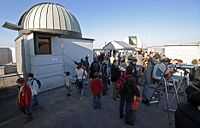Astronomy/Activities
< Astronomy
Astronomy/Activities is a collection of learning-by-doing resources focused on astronomy.
Laboratories
Some of these are laboratories that ask the student, teacher, or researcher to conduct an experiment by locating an object of interest on the web or making one up from their imagination.
Exercises
Others are participatory exercises for particular subjects of interest such as:
- Becoming an observer
- Binary Stars and Extrasolar Planets Learning Activity
- Cassiopeia and Ursa Major
- International Year of Astronomy
- Liquid water on Europa
- Lunar Boom Town
- Lunarpedia
- Observational astronomy
- Stellarium
Lessons
Lessons are activities that engage the participant in history-of-science original astronomical research.
Problems
Problem sets give the participants an opportunity to perform reasoning and mathematics.
Quizzes
Quizzes allow the students to test their knowledge and test-taking skills.
Theoretical astronomical activities
These are laboratories designed to introduce alternative explanations for astronomical phenomena. Examples include
- Cosmogony laboratory,
- Electric orbits,
- Electron beam heating/Laboratory,
- Magnetic field reversal,
- Neutrinos from the Sun, and
- Polar reversals.
Entities
Sources
- Backyard Astronomy
- Globulars in M31
- Highest temperature on Jupiter
- Spectral analysis of stars
- Stargazing
- The visible sky
Objects
Research
Hypothesis:
- Ancient or prehistorical astronomers watched the skys with more interest than we do today.
Control groups

The findings demonstrate a statistically systematic change from the status quo or the control group.
“In the design of experiments, treatments [or special properties or characteristics] are applied to [or observed in] experimental units in the treatment group(s).[1] In comparative experiments, members of the complementary group, the control group, receive either no treatment or a standard treatment.[2]"[3]
Proof of concept
Def. a “short and/or incomplete realization of a certain method or idea to demonstrate its feasibility"[4] is called a proof of concept.
Def. evidence that demonstrates that a concept is possible is called proof of concept.
The proof-of-concept structure consists of
- background,
- procedures,
- findings, and
- interpretation.[5]
Proof of technology
"[T]he objective of a proof of technology is to determine the solution to some technical problem, such as how two systems might be integrated or that a certain throughput can be achieved with a given configuration."[6]
Def.
- "[a]n original object or form which is a basis for other objects, forms, or for its models and generalizations",[7]
- "[a]n early sample or model built to test a concept or process",[7] or
- "[a]n instance of a category or a concept that combines its most representative attributes"[7] is called a prototype.
Def. "[t]o test something using the conditions that it was designed to operate under, especially out in the real world instead of in a laboratory or workshop"[8] is called "field-test", or a field test.
A "proof-of-technology prototype ... typically implements one critical scenario to exercise or stress the highest-priority requirements."[9]
"[A] proof-of-technology test demonstrates the system can be used"[10].
"The strongest proof of technology performance is based on consistency among multiple lines of evidence, all pointing to similar levels of risk reduction."[11]
See also
- Articles
- Courses
- Astronomy Department
- Exercises
- Laboratories
- Lectures
- Lessons
- Problems
- Astronomy Project
- Quizzes
- Topics
References
- ↑ Klaus Hinkelmann, Oscar Kempthorne (2008). Design and Analysis of Experiments, Volume I: Introduction to Experimental Design (2nd ed.). Wiley. ISBN 978-0-471-72756-9. http://books.google.com/?id=T3wWj2kVYZgC&printsec=frontcover.
- ↑ R. A. Bailey (2008). Design of comparative experiments. Cambridge University Press. ISBN 978-0-521-68357-9. http://www.cambridge.org/uk/catalogue/catalogue.asp?isbn=9780521683579.
- ↑ "Treatment and control groups, In: Wikipedia". San Francisco, California: Wikimedia Foundation, Inc. May 18, 2012. Retrieved 2012-05-31.
- ↑ "proof of concept, In: Wiktionary". San Francisco, California: Wikimedia Foundation, Inc. November 10, 2012. Retrieved 2013-01-13.
- ↑ Ginger Lehrman and Ian B Hogue, Sarah Palmer, Cheryl Jennings, Celsa A Spina, Ann Wiegand, Alan L Landay, Robert W Coombs, Douglas D Richman, John W Mellors, John M Coffin, Ronald J Bosch, David M Margolis (August 13, 2005). "Depletion of latent HIV-1 infection in vivo: a proof-of-concept study". Lancet 366 (9485): 549-55. doi:10.1016/S0140-6736(05)67098-5. http://www.ncbi.nlm.nih.gov/pmc/articles/PMC1894952/. Retrieved 2012-05-09.
- ↑ "Proof of concept, In: Wikipedia". San Francisco, California: Wikimedia Foundation, Inc. December 27, 2012. Retrieved 2013-01-13.
- 1 2 3 "prototype, In: Wiktionary". San Francisco, California: Wikimedia Foundation, Inc. December 8, 2013. Retrieved 2014-01-03.
- ↑ "field-test, In: Wiktionary". San Francisco, California: Wikimedia Foundation, Inc. August 5, 2012. Retrieved 2013-01-13.
- ↑ A. Liu; I. Gorton (March/April 2003). "Accelerating COTS middleware acquisition: the i-Mate process". Software, IEEE 20 (2): 72-9. doi:10.1109/MS.2003.1184171. http://cin.ufpe.br/~redis/intranet/bibliography/middleware/liu-cots03.pdf. Retrieved 2012-02-15.
- ↑ Rhea Wessel (January 25, 2008). "Cargo-Tracking System Combines RFID, Sensors, GSM and Satellite". RFID Journal: 1-2. http://www.rfidjournal.com/article/pdf/3870/1/1/rfidjournal-article3870.PDF. Retrieved 2012-02-15.
- ↑ P. Suresh, C. Rao, M.D. Annable and J.W. Jawitz (August 2000). E. Timothy Oppelt. ed. [http://www.afcee.af.mil/shared/media/document/AFD-071003-081.pdf#page=108 In Situ Flushing for Enhanced NAPL Site Remediation: Metrics for Performance Assessment, In: Abiotic In Situ Technologies for Groundwater Remediation Conference]. Cincinnati, Ohio: U.S. Environmental Protection Agency. pp. 105. http://www.afcee.af.mil/shared/media/document/AFD-071003-081.pdf#page=108. Retrieved 2012-02-15.
External links
- International Astronomical Union
- NASA/IPAC Extragalactic Database - NED
- NASA's National Space Science Data Center
- The SAO/NASA Astrophysics Data System
- SDSS Quick Look tool: SkyServer
- SIMBAD Astronomical Database
- SIMBAD Web interface, Harvard alternate
- Spacecraft Query at NASA.
- Universal coordinate converter
![]() This is a research project at http://en.wikiversity.org
This is a research project at http://en.wikiversity.org
| |
Educational level: this is a research resource. |
| |
Subject classification: this is an astronomy resource. |